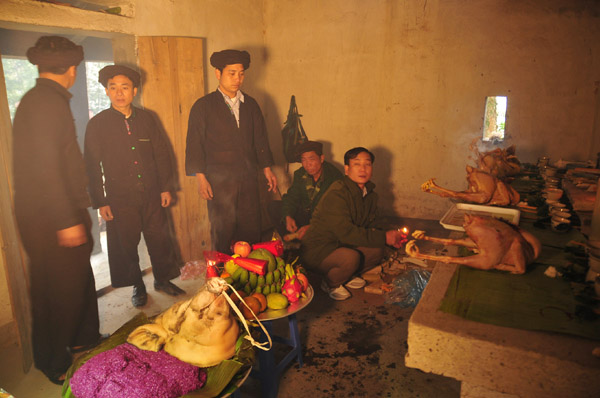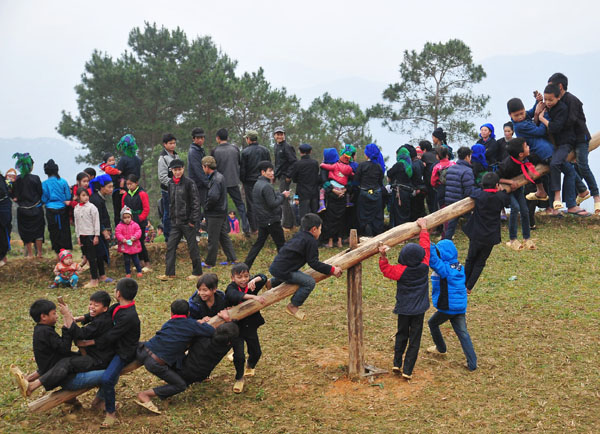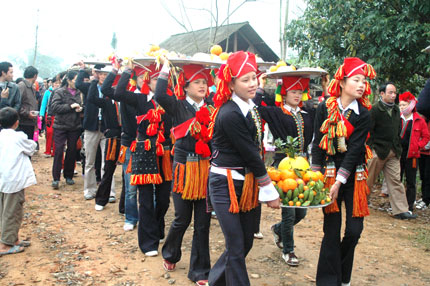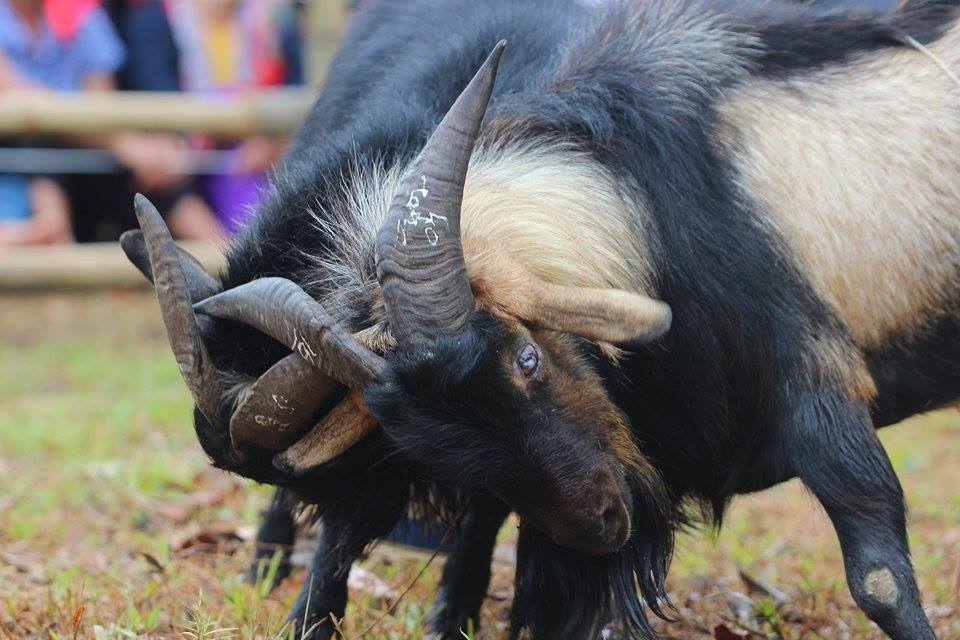If you come to Ha Giang in the late spring and early summer, visit Vinh Quang town in Hoang Su Phi district where you will be overwhelmed with beautiful wild and majestic mountains here. Considered to be a mountainous district with vast mountain landscapes which are the most magnificent, Hoang Su Phi is a place of interest that cannot be missed.
To reach Hoang Su Phi, at Bac Giang junction visitors have to change the car and then go 58 kilometers more. Hoang Su Phi is located in the west of Ha Giang province, at the foot of the Tay Con Linh wonder. It is divided by limestone karst and streams, thus creating a beautiful natural setting, perfectly blended with endless terraces – a stop for those who like to take a scenic walk and discover the wonders of the indigenous people’s life here. Sticking to the rice paddies and terraces from birth through maturity and till they die and return back to ancestors as tradition, the culture, the rituals, the beliefs of people here associated with the trees, mountains, paddy rice, terraced fields which makes difference in the culture of the people here from other ethnicities. Hence, the indigenous in Hoang Su Phu also has their own festivals to celebrate and thank gods and nature according to their distinguished rituals, beliefs and ways of life.
- Mo Đồng Trư – the Nùng’s forest land worship

Preperation for the festival – Source: baohagiang
Forest worship is a unique festival of the Nung ethnic group in the commune of Po Lo, Hoang Su Phi district, Ha Giang province. With the concept and belief: the forest is the mother of human beings, then people have to know how to preserve the forest. Every year on lunar February 2nd, people here eagerly prepare offerings to give the forest with hope for a peaceful life. In this festival, Nung families donate money to buy food and the sacrifice ceremony to offer tribal chief Cản Lùng – the forest god in their legendary story at the temple shrine built in the middle of the forbidden forest, to pray Cản Lùng for a year of lush fresh harvest, health, and happiness.
In the sacred space of the forbidden forest, all people participating in the festival voluntarily obey the regulations: No curse, no too much alcohol drinking that may accidentally offend the gods. And there is an absolute taboo for women and young children that they are not allowed to set foot in the forest during the ceremony. Everything in preparation ceremony including food processing are under men responsibility. After the sacrifice ceremony ends, the chief priests and elders and village chiefs in the commune will taste the cooked dishes partly first as parts of the ceremony and all the other meat sacrifices left will be processed into dishes for everyone in the commune to enjoy.
Immediately after accomplishing the sacrifice stage, people in the village participate in the games and dances fully colored by beliefs of the Nung ethnic group.

Traditional game in the festival – source: baohagiang.vn
- The rice worship

Image source: thegioidisan.vn
According to Red Dao’s perspective in Hoang Su Phi (Ha Giang), rice also has the soul. Therefore, every year, to have bumper crops, the Red Dao must organize sacrifices ceremony calling the soul of rice and of rice leaves to let them together come to the owner’s crops, making a good season. Feasts of worship include carp, sticky rice, new rice, green vegetables, honey bee, crabs from streams, etc.
Mr. Triệu Chòi Hín in Ho Thau commune shared that rice sacrifice session has 3 main contents.
The first is to pray for the ancestors bless the family healthy, for the bad to be chased away, the good be picked up. Next, it is reported to the ancestors, that rice in the field is sure to be mature, is about to ripe, looking forward ancestors and rice gods to protecting the crops and not to allow any animal to eat the rice on the field. The third part is also the most important part – inviting the soul of the rice to come back by saying: “scattered paddies of the previous season, invite your friends to go home together, not to wander anywhere more.”
- Early spring goat fight

Image source: vietnamnet.vn
On the occasion of the spring, beside the traditional festivals of Mong people, Hoang Su Phi district (Ha Giang) also organizes goat fight festival to attract many ethnic people and tourists to see.
Living the struggle against the harshness of nature, ethnic people here mainly work on the agricultural production, especially cattle breeding. In particular, goats are always considered as animals change life, bringing warmth and well-being to the people.
In each goat herd usually has a male leading, acting as a leader, but not for the protection of the herd but mainly for the maintenance of the race, since the goat is one of the animals with high sexual ability. Along with raising goats, people long ago often have led goat to fight each other. This activity, on the one hand, is for entertainment but hidden the other hand is the conception of proliferation and the survival of the race living in their traditional belief.
The goats participating in the competition must be healthy, age 3 years or older, have a clear origin and not bear any disease. Available in weight classes of 25 – 30 kilogram, 30 – 35 kilogram and 40 – 45 kilogram. In the game, if the fight does not come to any winner, the referee will base on the ways that goals attack or choose one which has more effective hit to decide to win. whether win or lose, goats are not killed but continue to come back and live with their herd. Goals achieving high prizes will be selected for breeding.
Participants in the festival are households and individuals working or doing business in the communes in the district with good goats under the ownership of the family registered to participate. However, no more than two goals in each commune be joined in. Pairs of goats participating in the contest must be pre-selected in the communes and towns before the festival at least 20 days.
The festival usually takes place on the first day of the second month of the lunar calendar when the plowing job has been set aside. The time limit for each match is 15 minutes, but there are the tough matches when goats are very exciting, the game lasts 30-40 minutes. Unlike buffalo and horse fighting, goat fighting has many unique features. Goats come to play with excitement and behave politely. Though they look not very huge and seem weak, when put into the battle, their bravery is masculinely shown.
Training goals to become a real “fighter” who has the ability to launch decisive martial arts knocking down the enemy and defeat combines detailed schedules in eating and exercising in addition to the getting separated from their herd and fed on their own. Generally, goats must be of age of one year or more to be “mature” and intelligent to participate in training. Two months before the competition, the goat owner usually provides durable running sessions to the goats to practice their bodies’ flexibility. Training for goats is one of the many ways to gain experience before the fight.
Goat fighting is a culture of healthy entertainment, creating a lively joyful atmosphere in the early days of spring. This is also a chance for people to exchange experience in goal breeding, in family economic development, strengthening the spirit of solidarity in the community of upland ethnic groups.
Translator: Dam Trang
